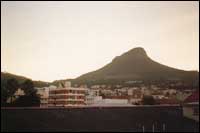
Meet Kids in South Africa
Lion's Head mountain (photo: Lorraine Greenwald)
Students at Atholl Heights in Durban and Sunridge Primary School in Port Elizabeth, South Africa, are, for the most part, proud of their country, their city, and their schools. Like many South Africans, they love the outdoors of their beautiful country. Many of them hike, play rugby, squash, and cricket, and go rollerblading. Durban and Port Elizabeth are both on the coast, which provides lots of opportunities for students at both schools to enjoy surfing and boogie boarding — which is like surfing except you lie flat on the board.
![]()

![]()
South Africa is famous for its game reserves, where you can find many wild animals, including rhinos, lions, elephants, leopards, and buffalo. But the students here want kids in other parts of the world to know that you won't find these animals running around the city streets!
Students at both schools are enthusiastic participants in their music programs. At Sunridge Primary, more than 250 kids perform in an operetta every two years. These performances take place in the Port Elizabeth Opera Hall, and they usually sell out all eight shows. At Atholl Heights, the students give two concerts each year, with the Junior Primary kids — from grades 1 through 3 — performing in one and the Senior Primary kids — grades 4 through 7 — performing in the other.
Unlike many schools in South Africa, Atholl Heights has students from several different races. Almost half of the students are descended from Asian ancestors, mostly Indian. Half of the students are white, and about five percent of the students are black. At Sunridge Primary, the majority of the students are white. For many years, under a system called apartheid, black and white kids in South Africa were not allowed to go to school together. Black people were also not allowed to vote, and could not live in the same neighborhoods where whites lived or hold the jobs that were reserved for whites only. Asians were classified as "colored," and had more rights than blacks, but fewer than whites.
Today, people of all races in South Africa have the same legal rights, but many blacks are still very poor. Most black parents cannot afford to send their kids to schools like Sunridge Primary and Atholl Heights.
While students at these schools enjoy many of the same things that kids everywhere enjoy, they know that they are living during a time of exciting and difficult transformation in their country. South Africa began to end apartheid in 1989, and people of all races were allowed to vote in a national election for the first time in 1994. Nelson Mandela was elected as the first black president in the country's history.
But the country still faces some serious problems. Parts of the country are as well off economically as any part of the United States, while in other areas, the people are very poor. Some conflict remains between black people and white people. Much of the country is concerned about crime. According to Lloyd Wing, the deputy principal of Atholl Heights, "The violence is absolutely terrible." In spite of all these problems, Mr. Wing is hopeful. "We have found at Atholl Heights that children from different cultures adapt very well and seem to get along without too many problems. This gives us some hope for the future."
Kids from both schools answered questions about their country, so check out their replies!
Daily Life
|